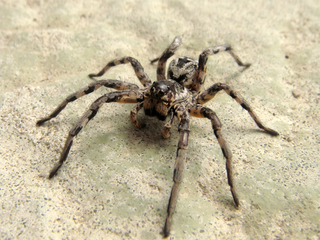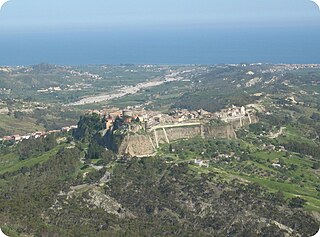Tarantella is a group of various southern Italian folk dances originating in the regions of Calabria, Campania and Puglia. It is characterized by a fast upbeat tempo, usually in 6
8 time, accompanied by tambourines. It is among the most recognized forms of traditional southern Italian music. The specific dance-name varies with every region, for instance Sonu a ballu in Calabria, tammurriata in Campania, and pizzica in Salento. Tarantella is popular in Southern Italy, Greece, Malta, and Argentina. The term may appear as tarantello in a linguistically masculine construction.

Dancing mania was a social phenomenon that occurred primarily in mainland Europe between the 14th and 17th centuries. It involved groups of people dancing erratically, sometimes thousands at a time. The mania affected adults and children who danced until they collapsed from exhaustion and injuries, and sometimes died. One of the first major outbreaks was in Aachen, in the Holy Roman Empire, in 1374, and it quickly spread throughout Europe; one particularly notable outbreak occurred in Strasbourg in 1518 in Alsace, also in the Holy Roman Empire.

The following discography contains information regarding some of the published recordings by Enrico Caruso made from 1902 through 1920 as have been made available in selected compact disc compilations.

Lycosa tarantula is the species originally known as the tarantula, a name that nowadays in English commonly refers to spiders in another family entirely, the Theraphosidae. It now may be better called the tarantula wolf spider, being in the wolf spider family, the Lycosidae. L. tarantula is a large species found in southern Europe, especially in the Apulia region of Italy and near the city of Taranto, from which it gets its name.
The Music of Apulia has had some glorious history as well as some very hard times. Located along the southern Adriatic, the area was part of Magna Grecia and certainly one of the centers of Ancient Greek music. And 1,000 years ago, Bari, on the coast, was a privileged sanctuary for pilgrims and Crusaders on their way to the Holy Land. Yet, the only musical relic that remains from the period is the Excultet, a representation from the 11th century of two angels playing trumpets that is preserved in the Basilica of San Nicola in Bari. Later, as part of the Kingdom of Naples, Apulia produced many memorable names in music, but like elsewhere in the south, many of them gravitated to Naples, the capital of the kingdom.

A spider bite, also known as arachnidism, is an injury resulting from the bite of a spider. The effects of most bites are not serious. Most bites result in mild symptoms around the area of the bite. Rarely they may produce a necrotic skin wound or severe pain.

The Feast of Saints Peter and Paul or Solemnity of Saints Peter and Paul is a liturgical feast in honor of the martyrdom in Rome of the apostles Saint Peter and Saint Paul, which is observed on 29 June. The celebration is of ancient Christian origin, the date selected being the anniversary of either their death or the translation of their relics.
Italian music terminology consists of words and phrases used in the discussion of the music of Italy. Some Italian music terms are derived from the common Italian language. Others come from Spanish, or Neapolitan, Sicilian, Sardinian or other regional languages of Italy. The terms listed here describe a genre, song form, dance, instrument, style, quality of music, technique or other important aspect of Italian music.

Caulonia is a comune (municipality) in the Province of Reggio Calabria in the Italian region Calabria, located about 60 kilometres (37 mi) southwest of Catanzaro and about 120 kilometres (75 mi) northeast of Reggio Calabria in the Stilaro Valley. Originally it was known as Castelvetere, but in 1862 the citizens decided to change the name of the town to that of the ancient city Caulonia. They believed that this city had been located on their territory, but it was eventually proved that ancient Caulonia was to be found near modern Monasterace, 16 kilometres (10 mi) to the northeast.

Tarantulas comprise a group of large and often hairy spiders of the family Theraphosidae. As of December 2023, 1,100 species have been identified, with 166 genera. The term "tarantula" is usually used to describe members of the family Theraphosidae, although many other members of the same infraorder (Mygalomorphae) are commonly referred to as "tarantulas" or "false tarantulas". Some of the more common species have become popular in the exotic pet trade. Many New World species kept as pets have setae known as urticating hairs that can cause irritation to the skin, and in extreme cases, cause damage to the eyes.

Nino Taranto was an Italian film actor. He appeared in more than 80 films between 1924 and 1971.

The dancing plague of 1518, or dance epidemic of 1518, was a case of dancing mania that occurred in Strasbourg, Alsace, in the Holy Roman Empire from July 1518 to September 1518. Somewhere between 50 and 400 people took to dancing for weeks. There are many theories behind the phenomenon, the most popular being stress-induced mass hysteria, suggested by John Waller. Other theories include ergot and religious explanations. There is controversy concerning the number of deaths.
Hysterocrates gigas is a member of the tarantula family, Theraphosidae found in Cameroon. It is known as the giant baboon spider, Cameroon red baboon spider, or red baboon tarantula.

Italian folk dance has been an integral part of Italian culture for centuries. Dance has been a continuous thread in Italian life from Dante through the Renaissance, the advent of the tarantella in Southern Italy, and the modern revivals of folk music and dance.

Eugenio Bennato is an Italian folk musician and songwriter. He is the brother of the musician Edoardo Bennato.

Ellade Bandini is an Italian drummer.

Alessandra Belloni is an Italian musician, singer, dancer, actress, choreographer, teacher, and ethnomusicologist. Her instrument is the Southern Italian tambourine and her music and dance are focused on the traditional roots of tarantella. Her studies of tarantism are rooted in the culture of Apulia and Calabria, expressing it from women's point of view. Her work has gained international appreciation, especially in the United States and Brazil. She is artist in residence at the Cathedral of St. John the Divine.
Matteo Cancellieri is an Italian professional footballer who plays as a winger or second striker for Serie A club Empoli, on loan from Lazio. He also plays for the Italy national team.

The Dancing Mania, an epidemic of the Middle Ages is a historical-pathological investigative book originally written and published in German by Justus Friedrich Karl Hecker (1795-1850) in 1832 as Die Tanzwuth, eine Volkskrankheit im Mittelalter: nach den Quellen für Aerzte und gebildete Nichtärzte bearbeitet. The full translated English title is The Dancing Mania, an epidemic of the Middle Ages: from the sources of physicians and non-physicians. Hecker combines multiple sources about the dancing mania, an epidemic which occurred mainly between the 14th and 17th century of the Middle Ages. The dancing mania is described by the author as a historical case of mass hysteria, and Hecker further investigates the conditions and circumstances surrounding the dancing mania during the outbreaks. The book has also been published in combination with The Black Death in the fourteenth century (1832) and The Sweating Sickness: A medical contribution to the story of the fifteenth and sixteenth century (1834) in a book called The Epidemics of the Middle Ages by doctor August Hirsch in 1865 after Hecker's death. The Dancing Mania (1832) sparked new interest in the dancing plague and mass hysteria at the time of publication, leading to much further research on the topic.














